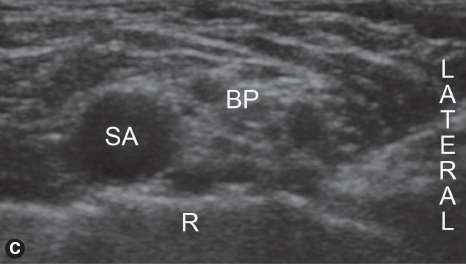Important surface landmarks include the sternocleidomastoid (SCM) and clavicle.
The SCM may be identified by asking the patient to turn the head away from the affected side and flex the neck. Palpating the interscalene groove and subclavian artery pulsation posterior to the SCM is also helpful.

A. Surface anatomy relevant to the supraclavicular block. The “X” marks the suggested site for needle insertion when performing the plumbbob technique with nerve stimulation. SCM, sternocleidomastoid muscle; C, clavicle. B. A highfrequency linear transducer is placed perpendicular to skin medial to the clavicle. The block needle is inserted lateral to the transducer and directed anteromedially for inplane needle guidance.
Approach and Technique
 With a HF linear ultrasound transducer positioned cephalad and medial to the midpoint of the clavicle and oriented vertically,
With a HF linear ultrasound transducer positioned cephalad and medial to the midpoint of the clavicle and oriented vertically,  the brachial plexus is visualized in shortaxis posterolateral to the subclavian artery.
the brachial plexus is visualized in shortaxis posterolateral to the subclavian artery.
After sterile skin preparation, a local anesthetic skin wheal is raised lateral to the ultrasound transducer. The block needle is inserted through the skin wheal and directed anteromedially toward the subclavian artery.
US-GUIDED SUPRACLAVICULAR BLOCK

Stay updated, free articles. Join our Telegram channel

Full access? Get Clinical Tree






